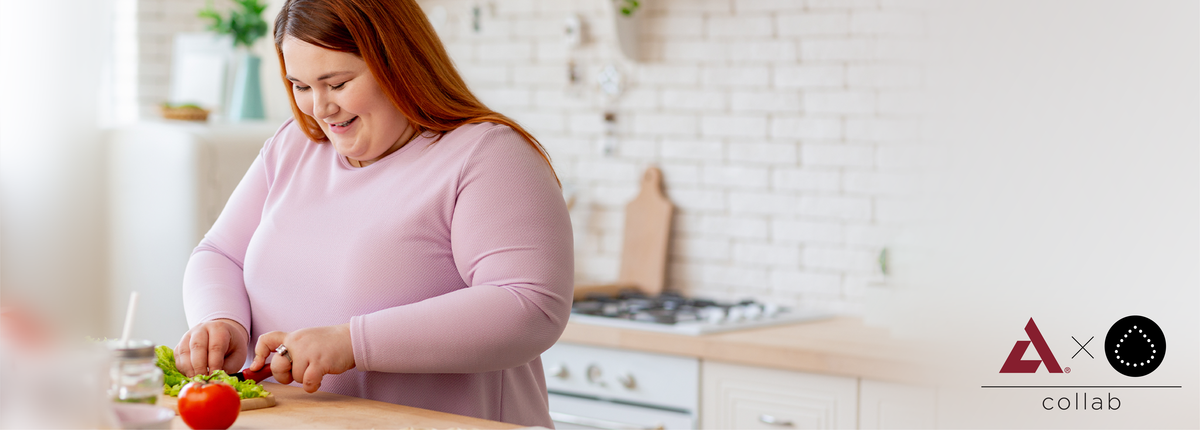What are 2 changes I can make in my diet for a big impact on my diabetes?
This educational content is brought to you by the ADA x BT1 Collab.
The following transcript has been edited for length and clarity.
Ginger Vieira: Welcome to the Collab Conversations with the American Diabetes Association and Beyond Type 1. My name is Ginger Vieira. And with me today is Dr. Laura Hieronymus, vice president of Healthcare Programs and she’s also at CDCES.
Dr. Laura Hieronymus: Hey, good to be here.
So I would love to pick your brain about one or two small changes that someone could make in their relationship with food, their habits around food that could have a big impact on their diabetes health.
That’s a really good question. I think one of the things as a diabetes care and education specialist that we try to do is help individuals understand what their dietary pattern is. So what dietary pattern means, it’s thinking about the common foods that you eat or drink as well as how much you eat or drink them and how often that you consume. So really to be successful with making changes in your diet, you really should have an individualized plan. And so working with a registered dietician nutritionist, ideally one that specializes in diabetes is a great first step.
Okay. And a plan doesn’t mean a diet that’s perfect. And just chicken and broccoli all day long. It’s helping you shape your real life around food in a way that you can actually maintain long-term. Right?
Very good. And you just described the dietary pattern. One of the things that you can do is, learn to interpret a nutrition facts label. There’s a reason it says facts and that’s because it’s chock full of information about what you eat. And so when you look at the nutrition facts label, you can see, for example, how much carbohydrate, which has the greatest impact on your blood glucose. You can see how much carbohydrate that serving of food or drink has on your blood glucose levels. So for example, if you are, I think you talked earlier about drinking ginger ale all day, if you’re drinking ginger ale all day, you need to know how much carbohydrate it contains.
It’s easy to sip on soda or juice all day, not realizing that you’ve now consumed 150 grams of sugar in one day.
One might think, okay, well, Ginger Ale’s not very healthy. Well, it really doesn’t have any substance in it for nutrition. So you’re getting a large amount of carbohydrate without any nutrition. Now, on the other hand, fruit juice. Fruit juice has some, some nutrition chopped in it, but it also has carbohydrates in it. And so it’s very important to understand using the nutrition facts label, how much carbohydrate that juice actually contains. So very important to be able to look at those nutrition facts labels,
And a glass of orange juice could have 60 grams of sugar with carbs in it versus the actual orange, more like 20 grams with a lot of fiber, right?
Right. So I think, you know, learning those types of things and learning again, back to the types of foods you eat and drink, what makes the most sense and how you navigate the nutrition facts to really help you balance your meal plan.
Okay. So it sounds like a really simple first step that someone could take is to just write down what they eat and drink for a few days and take a look at it. How many times a day are you eating a sugary snack or drinking pure carbohydrate? And then take some simple steps from there to just look at your habits.
Well, I think you want to make sure that you’re accurate, right? And it’s not a test, it’s just information. It’s just providing you with information and learning to navigate.
And then of course, carbs are just one part of your entire diet. Looking at whole foods, how much food you’re eating versus processed food and obvious sources of sugar are not the only things that raise blood sugar levels. Processed flour and pasta processed breads, just to look at the whole picture.
Well, and I think that’s important too, because you can make better choices within that particular food, for example, whole grain or whole wheat bread, as opposed to the white bread. Is a better choice because it’s got fiber in it. And it’s healthier in terms of…
…impact.
Impact and nutrition. Yes.
Okay. Well, thank you so much for simplifying what is a very daunting topic, right? When someone is faced with trying to improve their relationship with food, where do you start? And it sounds like really just looking at what you eat for a few days and writing it down is a simple place to start.
Well, and again, following up with the registered dietician nutritionist, it works. It absolutely works in helping to lower A1C levels, helping improve daily blood glucose levels.
Okay. Well, thank you so much, Dr. Hieronymus.





